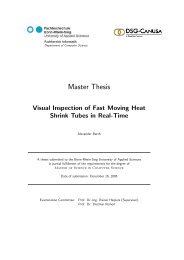Master Thesis - Hochschule Bonn-Rhein-Sieg
Master Thesis - Hochschule Bonn-Rhein-Sieg
Master Thesis - Hochschule Bonn-Rhein-Sieg
You also want an ePaper? Increase the reach of your titles
YUMPU automatically turns print PDFs into web optimized ePapers that Google loves.
5. Algorithms <strong>Master</strong> <strong>Thesis</strong> Björn Ostermann page 93 of 126<br />
From the intrusion map, shown in Figure 65a, the robot area is excluded.<br />
In Figure 65b the algorithm calculates a line from the centre of the robot’s base position to the first<br />
pixel on the border of the intrusion map. Along this line every pixel that is crossed by the line is<br />
checked for intrusion. If a pixel containing an intrusion is found, as well as when the border-pixel is<br />
reached, the algorithm stores that pixel as an unreachable pixel and the next border-pixel is tried to be<br />
reached (Figure 65c and d – stopped at the blue pixels).<br />
The algorithm checks each border-pixel once, until all border-pixels are checked, as shown in Figure<br />
65e.<br />
From the remembered pixels in Figure 65e, the border of the reachable space is generated (Figure 65f)<br />
by drawing a closed line (borderline) through the remembered pixels. This borderline marks the first<br />
pixels that can not be reached.<br />
5.5.4 Selection of significant part<br />
When the robot is moving from one point to another, not all of the reachable space is necessary to<br />
compute the collision free space, but only the part that is between the current robot position and the<br />
position of the goal.<br />
Therefore, in this algorithm:<br />
- The borderline is transformed from the camera’s coordinate system into the robot’s coordinate<br />
system.<br />
- The coordinates of the pixels of the borderline are transformed from Cartesian coordinate system<br />
to Polar coordinate system, the system of the robot’s axes.<br />
- The significant part of the borderline lying between the current robot’s angle and the goal<br />
position’s angle is selected.<br />
The first step in the selection algorithm, transforming the values of the borderline into the robot<br />
coordinate system, is achieved by applying the transformation matrix determined in chapter 5.5.2.<br />
There are problems that have to be solved before transforming the values:<br />
- It was observed during this thesis that in the outer regions of the acquired distance images the<br />
camera’s measurements sometimes wrongly show a very short distance.<br />
- The safety distance has to be dependant on the tool centre point’s height, since the robot can<br />
work directly below an intrusion, as long as the angle of the camera allows a clear separation (see<br />
Figure 66) of the robot and the intruding object.<br />
- The reverse of the second point is true as well, where a high position of the tool centre point casts<br />
a blind spot on intruding objects that are farther away in the horizontal direction but on a lower<br />
position.














